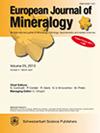德国黑森林南部多阶段萤石成矿:来自稀土元素地球化学的证据
IF 1.7
3区 地球科学
Q2 MINERALOGY
引用次数: 0
摘要
摘要黑森林拥有广泛的热液矿化,包括萤石-重晶石矿脉矿床。在对Wieden矿区(黑森林南部)Finstergrund和Tannenboden矿床的详细调查中,根据稀土元素地球化学、地质场关系和晶体分区,追踪了多阶段萤石降水的多样性、地球化学演化和相对年代。地球化学判别和数学λ系数表明,矿床共有七个萤石REE组,至少有三个可区分的华力西后期流体活动事件和独立的形成历史,尽管它们在空间上很接近。Finstergrund矿床的萤石脉矿化经过三次流体成矿作用演化而来,来源于片麻岩源含水层,包括五个不同的萤石REE组:第一次流体生成的特征是萤石沉淀超过200 ∘C(“III组”),低于200 ∘C组(“I组”)和分级结晶后(“IV组”);第二代包括再活化萤石(“II族”);第三代揭示了由大气降水混合形成的萤石沉淀(“V组”)。Tannenboden矿床的萤石脉形成与同一流体生成的两种不同的萤石REE模式有关:200以上的萤石沉淀 ∘C(“第VII组”),冷却至200以下 ∘C(“第六组”)。其流体源含水层岩性与混合岩最匹配,与之前的模型相反,该模型表明黑森林中萤石脉沉淀的含水层岩石为片麻岩或花岗岩。Wieden矿区的一个新的成因模型表明,矿床之间的解耦形成历史受到构造控制。该模型认为,在第一次流体动员事件后,Tannenboden矿床的局部流体渗流网络发生了变化,热液活动终止。Tannenboden和Finstergrund矿床与黑森林中的其他萤石矿化相结合,证明了多级萤石矿化的地球化学演化,为大型热液系统中发生的各种流体-岩石相互作用过程中萤石的岩石圈起源和沉淀行为提供了独特的见解。稀土元素模式的局部多样性强调了对单个热液矿脉矿床进行详细研究的必要性。本文章由计算机程序翻译,如有差异,请以英文原文为准。
Multistage fluorite mineralization in the southern Black Forest, Germany: evidence from rare earth element (REE) geochemistry
Abstract. The Black Forest hosts a wide range of hydrothermal
mineralization, including fluorite–barite vein deposits. In a detailed
investigation of the Finstergrund and Tannenboden deposits in the Wieden
mining district (southern Black Forest), the diversity, geochemical evolution
and relative chronology of multistage fluorite precipitation is tracked on
the basis of rare earth element (REE) geochemistry, geologic field relationships and crystal
zoning. Geochemical discrimination and mathematical λ coefficients
suggest a total of seven fluorite REE groups, at least three distinguishable
post-Variscan fluid mobilization events and independent formation histories
for the deposits despite their spatial proximity. Fluorite vein
mineralization at the Finstergrund deposit evolved over three fluid
generations, was derived from gneissic source aquifers and comprises five
distinct fluorite REE groups: the first fluid generation is characterized by
fluorite precipitation above 200 ∘C (“group III”), below 200 ∘C (“group I”) and after fractional crystallization (“group IV”);
the second generation comprises remobilized fluorite (“group II”); and the
third generation revealed fluorite precipitation by meteoric water mixing
(“group V”). Fluorite vein formation at the Tannenboden deposit is
associated with two distinct fluorite REE patterns derived from the same
fluid generation: fluorite precipitation above 200 ∘C (“group
VII”) and after cooling below 200 ∘C (“group VI”). Its fluid
source aquifer lithology best matches migmatites contrary to previous models
that suggest either gneissic or granitic aquifer rocks for fluorite vein
precipitation in the Black Forest. The decoupled formation history between
the deposits is tectonically controlled as suggested by a new genetic model
for the Wieden mining district. The model argues for a change in the local
fluid percolation network and the termination of hydrothermal activity at
the Tannenboden deposit after the first fluid mobilization event. The geochemical evolution of multistage fluorite mineralization, as
exemplified by the Tannenboden and Finstergrund deposits in combination with
other fluorite mineralizations in the Black Forest, provides unique insights
into the lithospheric origin and precipitation behaviour of fluorite by
various fluid–rock interaction processes occurring in large hydrothermal
systems. The local diversity of REE patterns emphasizes the need for
detailed investigations of individual hydrothermal vein deposits.
求助全文
通过发布文献求助,成功后即可免费获取论文全文。
去求助
来源期刊
CiteScore
2.80
自引率
9.50%
发文量
40
审稿时长
6-12 weeks
期刊介绍:
EJM was founded to reach a large audience on an international scale and also for achieving closer cooperation of European countries in the publication of scientific results. The founding societies have set themselves the task of publishing a journal of the highest standard open to all scientists performing mineralogical research in the widest sense of the term, all over the world. Contributions will therefore be published primarily in English.
EJM publishes original papers, review articles and letters dealing with the mineralogical sciences s.l., primarily mineralogy, petrology, geochemistry, crystallography and ore deposits, but also biomineralogy, environmental, applied and technical mineralogy. Nevertheless, papers in any related field, including cultural heritage, will be considered.

 求助内容:
求助内容: 应助结果提醒方式:
应助结果提醒方式:


